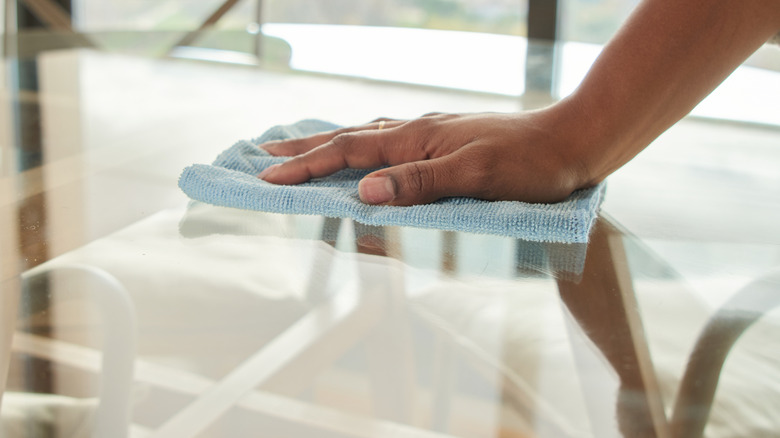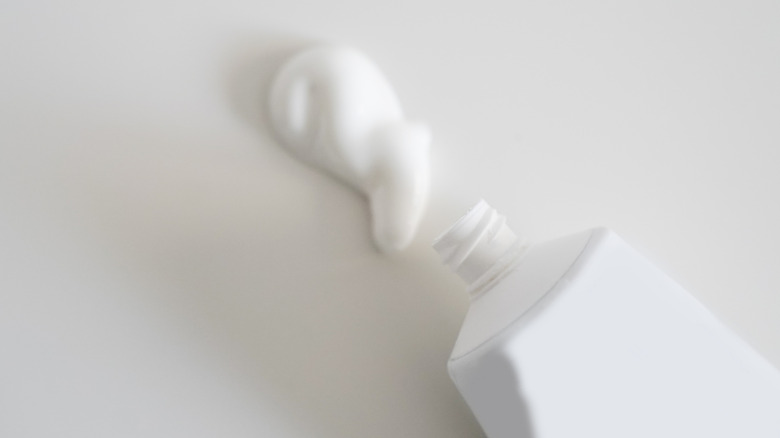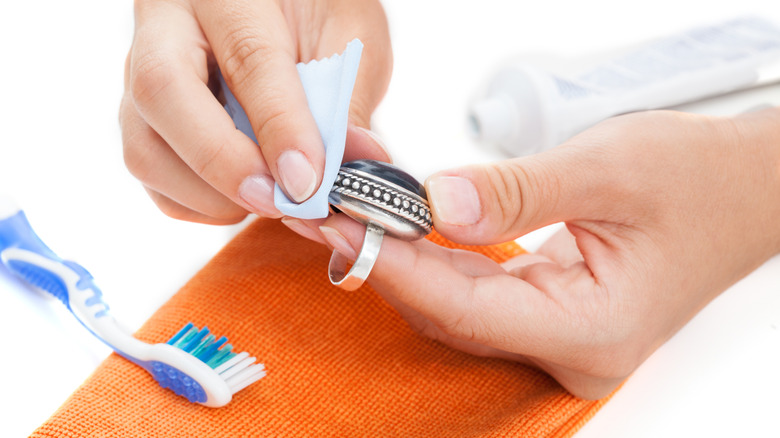The Bathroom Staple That'll Help You Easily Remove Glue From Glass
Remember that moment when a DIY went awry, and one of your project ingredients ended up where it was not supposed to be? It's a moment of dread when something like that happens — particularly when it's a situation as high stakes as when glue ends up on your high-end glass top table or your prescription glasses. But, lucky for us messy DIYers, there's a solution for accidental glue on surfaces, specifically delicate ones like glass, and it's something every household has: toothpaste.
Toothpaste contains gentle abrasives coupled with chemicals aimed at breaking down compounds like plaque on the teeth. These qualities help chip away at adhesives like glue, but toothpaste is also a gentle enough solvent that can be used on delicate or soft surfaces like glass. Therefore, removing glue with toothpaste can work well for glass you don't want to chance scratching. And lucky for you, toothpaste can be used to clean so many other spots in the bathroom and throughout the house as well — who knew this bathroom staple was so versatile in the home!
A step-by-step guide to removing glue from glass
Using toothpaste to remove glue from glass surfaces is a fairly simple process. First, dab the glue with some warm water, dampening the spot slightly. Then, squeeze some toothpaste onto a soft cloth, and rub the toothpaste into the damp glue spot. Work the toothpaste in until the glue lifts off the glass service, but be sure not to apply too much pressure on the glue. Though toothpaste only has gentle abrasives, you still run the risk of scratching particularly delicate surfaces with small abrasions. While you can remove scratches from glass surfaces with the household staple of baking soda, it's best to try to prevent scratches from occurring in the first place.
On one hand, while you do want to be gentle and scratching is still a possibility with toothpaste, there are some instances when toothpaste may not be strong enough to get the glue off your glass surfaces. If this is the case, then try using a stronger household item like acetone. There are plenty of nail polish remover hacks to use around the house, and it makes a great pinch hitter when the milder toothpaste can't quite complete the de-gluing task. However, acetone is much stronger and more astringent than toothpaste, so don't run the risk if it makes you uncomfortable to use such a powerful cleaning agent on your gluey surface.
Toothpaste's best cleaning uses around the house
Toothpaste is a sleeper hit when it comes to cleaning in the home. Not only is it gentle and mildly abrasive — which helps with tasks like cleaning sinks or polishing jewelry — it's also antibacterial in nature so it can help sanitize surfaces as well. In many cases, applied in conjunction with a small cloth, toothbrush, or sponge, toothpaste can lift stains, dirt, and grime off of surfaces or even clothes and shoes. And, the scent of toothpaste is a great room deodorizer as well when you clean items in the space.
One of the most unusual ways to use toothpaste in your cleaning tasks around the home includes pest control as well. Evidently, creepy crawlers are not a fan of the tiny, spikey bits of calcium in toothpaste, so they steer clear of it (just be careful not to apply fluoride in your garden, as it can harm plants). Other unusual uses, like removing scuff marks on furniture, are great everyday ways to keep your home looking fresh. All in all, toothpaste is the handy bathroom essential that'll help keep your space nice and clean, and will help you recover from those potentially messy, glue-based DIYs!


